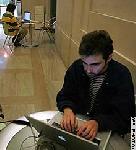 Almotamar Net
Almotamar Net - (AP) -- In another time and place, college students wondering whether the campus cafe has any free seats, or their favorite corner of the library is occupied, would have to risk hoofing it over there.
But for today's student at the Massachusetts Institute of Technology, that kind of information is all just a click away.
MIT's newly upgraded wireless network -- extended this month to cover the entire school -- doesn't merely get you online in study halls, stairwells or any other spot on the 9.4 million square foot campus.
It also provides information on exactly how many people are logged on at any given location at any given time. It even reveals a user's identity if the individual has opted to make that data public.
MIT researchers did this by developing electronic maps that track across campus, day and night, the devices people use to connect to the network, whether they're laptops, wireless PDAs or even Wi-Fi equipped cell phones.
The maps were unveiled this week at the MIT Museum, where they are projected onto large Plexiglas rectangles that hang from the ceiling. They are also available online to network users, the data time-stamped and saved for up to 12 hours.
Red splotches on one map show the highest concentration of wireless users on campus. On another map, yellow dots with names written above them identify individual users, who pop up in different places depending where they're logged in.
"With these maps, you can see down to the room on campus how many people are logged on," said Carlo Ratti, director of the school's SENSEable City Laboratory, which created the maps. "You can even watch someone go from room to room if they have a handheld device that's connected."
Researchers use log files from the university's Internet service provider to construct the maps. The files indicate the number of users connected to each of MIT's more than 2,800 access points. The map that can pinpoint locations in rooms is 3-D, so researchers can even distinguish connectivity in multistoried buildings.
"Laptops and Wi-Fi are creating a revolutionary change in the way people work," Ratti said. The maps aim to "visualize these changes by monitoring the traffic on the wireless network and showing how people move around campus."
Some of the results so far aren't terribly surprising for students at the vanguard of tech innovation.
The maps show, for example, that the bulk of wireless users late at night and very early in the morning are logged on from their dorms. During the day, the higher concentration of users shifts to classrooms.
But researchers also found that study labs that once bustled with students are now nearly empty as people, no longer tethered to a phone line or network cable, move to cafes and nearby lounges, where food and comfy chairs are more inviting.
Researchers say this data can be used to better understand how wireless technology is changing campus life, and what that means for planning spaces and administering services.
The question has become, Ratti said, "If I can work anywhere, where do I want to work?"
Graduate student Sonya Huang, stands in front of a map of the MIT campus that shows the flow of wireless Internet users at the school."Many cities, including Philadelphia, are planning to go wireless. Something like our study will help them understand usage patterns and where best to invest," said researcher Andres Sevtsuk.
Sevtsuk likened the mapping project to a real-time census.
"Instead of waiting every year or every 10 years for data, you have new information every 15 minutes or so about the population of the campus," he said.
While every device connected to the campus network via Wi-Fi is visible on the constantly refreshed electronic maps, the identity of the users is confidential unless they volunteer to make it public.
Those students, faculty and staff who opt in are essentially agreeing to let others track them.
"This raises some serious privacy issues," Ratti said. "But where better than to work these concerns out but on a research campus?"
Rich Pell, a 21-year-old electrical engineering senior from Spartanburg, South Carolina, was less than enthusiastic about the new system's potential for people monitoring. He predicted not many fellow students would opt into that.
"I wouldn't want all my friends and professors tracking me all the time. I like my privacy," he said.
"I can't think of anyone who would think that's a good idea. Everyone wants to be out of contact now and then."
